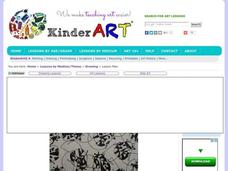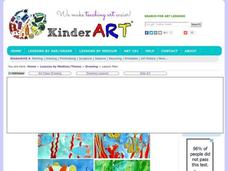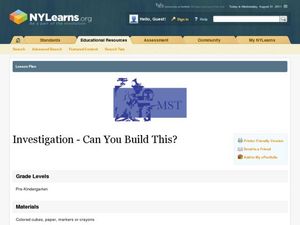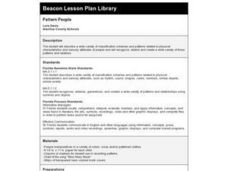Curated OER
And The Twelfth One Is
Ninth graders play guess my shape (either describe or use a feely bag to introduce the 3 shapes in the problem.) As they are identified put them in an order as shown in the problem. As the students work on the problem in pairs teacher...
Curated OER
The Function Box
Students look around classroom and identify any patterns they see, describe patterns and explain why they are patterns, use pencil to demonstrate arithmetic patterns by tapping, practice predicting patterns by using Function Box, and...
Curated OER
Sweet or Sour, Like or Different
Students watch a video on comparisons and discuss ways in which objects can be sorted. They play an identification game with a lemon and discuss identification characteristics.
Curated OER
Positive/Negative Bugs
Bugs can be creepy - and fun! Kids create a positive and negative design by repeatedly drawing a simple insect overlaid with a geometric shape. The outcome is really neat and will help build spacial reasoning, visual acuteness, and...
Curated OER
A Bug's Life
Look at life from a bug's perspective, and create a wonderful image based on what you think it sees. Learners use the crayon resist painting technique to draw and paint and picture of a bug's world from its point of view. Tip: This would...
Inside Mathematics
Squares and Circles
It's all about lines when going around. Pupils graph the relationship between the length of a side of a square and its perimeter. Class members explain the origin in context of the side length and perimeter. They compare the graph to the...
Curated OER
Under the Sea
Tropical fish are a great subject for any art project, they are colorful, interesting, and can go along with under water themed stories read in class, learner written narratives, or Marine Biology units. This set of instructions will...
Curated OER
Gumdrop Crystal Models
A great way to learn about molecular structures is to make a model. Gumdrops and toothpicks are used to construct crystal models. The models are based on theories of crystal shapes that occur because of positive and or negatively charged...
Curated OER
Studio Art Lessons Based on Latin American Arts
Study three of the basic principles of design: l) designs should create a rhythmic pattern made up of related shapes, 2) colors should be repeated so as to not force the eye to remain with a single part of the composition, and 3) a...
Curated OER
Investigation--Can You Build This?
Early learners explore shapes using colored blocks. They first get some hands-on time with the blocks and then look at beginning math concepts regarding spatial relationships. They work with a partner to build a 6-8 block tower with...
Curated OER
Take a Trip on the Chandelier
Students discuss the lines, shapes, and patterns used to decorate a 19th-century chandelier that was made to look like a hot-air balloon. In this art lesson students discuss the chandelier and then create a papier-mâché sculpture of a...
Curated OER
Pattern People
Students describe a wide variety of classification schemes and patterns related to physical characteristics and sensory attributes of people. They recognize, extend and create a wide variety of those patterns and relations.
Curated OER
Geo Jammin' By DeSign - Day 2, Lesson 11: A Stitch in Time
Students investigate the culturally artistic value of quilts, the importance of trade in meeting basic needs, and the conservation of natural resources.
Curated OER
Interpreting Data
In this interpreting data worksheet, students solve and complete 4 different types of problems using different data types. First, they collect raw data from a paragraph shown. Then, students identify the examples of two different types...
Science-Class.net
Rock Candy Crystals
Candy is one of my favorite words, and it's an even better word when it relates to science. Yes, candy science can happen when you grow rock candy crystals with your class. The entire process for growing these edible wonders of nature is...
Curated OER
Geo Jammin' By DeSign - Day 1, Lesson 2: Dancing Duo
Second graders and teachers identify geometric vocabulary word by searching a geometry website. They create a Quilt Word Wall using the geometry words.
Curated OER
Tessellation Trial and Error
In this interactive lesson, students review attributes of equilateral polygons. They are introduced to the concept of a tessellation. Using protractors and pre-cut shapes, students arrange a variety of tiles to create tessellations. They...
Curated OER
Fractal and the Dragon Curve
Students explore Fractal designs. In this geometry lesson, students observe the different polygons created in nature and relate it to math. They define polygons on planes and rotate polygons about a point.
Curated OER
Lunar Cycle
Students recognize that the eight phases of the moon repeat. In this lunar cycle instructional activity, students experiment to understand the phases of the moon. Students make observations and complete a "the Moon I See" worksheet. ...
Curated OER
Sampling Rocks
Students investigate rocks. In this earth science lesson, students collect rocks from the schoolyard and describe each of the rocks. Students measure and weigh each rock and record the results. Students create a rock guide for the...
Curated OER
Can You Build It?
Students investigate the concept of perimeter. They design there own figure and measure the perimeter of it. The lesson is given the context of the shape being a path that is traveled by a ladybug. This provides the shape of the plane...
Curated OER
Symmetrical Design: Pennsylvania Barn Signs
Second graders explain and apply the visual arts elements and the design principle of symmetry and apply media, techniques, and processes. In addition, they describe how different materials, techniques, and processes cause different...
Curated OER
Investigation - What's the Number?: Division
Seventh graders explore number sentences using a variety of strategies making each equation a true sentence. Students examine strategies such as patterns, trial and error, working backwards, and related problems. In groups, 7th graders...
Curated OER
Math is Beautiful: Tessellation
Learners examine patterning in Chinese and Japanese artwork prior to creating their
own tessellations using styrofoam plates in this creative cross-curricular lesson for upper-elementary/middle level classrooms.

























